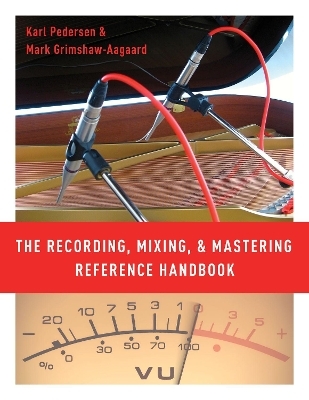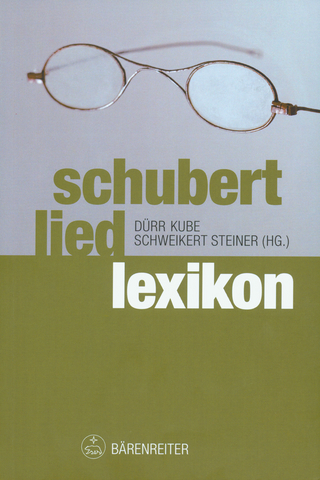
The Recording, Mixing, and Mastering Reference Handbook
Oxford University Press Inc (Verlag)
978-0-19-068663-5 (ISBN)
Throughout the chapters, lessons on recording methods gradually build complexity and detail to keep readers engaged and challenged. Whether a university student in an audio recording course, a novice audio engineer who needs to build technique, or a busy professional who requires a quick refresh on specific techniques, any reader will find an essential resource in The Recording, Mixing, and Mastering Reference Handbook.
Karl Pedersen owns and manages Blue Apple Lyd-design studios and Canta·Libris publishing house. In addition to having written several books on audio and sound, he also teaches music and sound technology and is a performing musician. Mark Grimshaw-Aagaard is Obel Professor of Music at Aalborg University, Denmark. He has published widely across subjects as diverse as sound, biofeedback in computer games, virtuality, the Uncanny Valley, and IT systems, and also writes free, open source software for virtual research environments (WIKINDX).
About the Companion Website
Introduction
PART I The Instruments (practical recording and mix-techniques)
Chapter 1 The Voice
Acoustics and microphone settings · Vocal psychology · The Headphone Mix · Tips · Various vocal techniques · The mix settings and effects · Special uses of vocal microphones · Harmony vocals as overdub · Tips
Chapter 2 The Drum Kit
The Instrument and the acoustics · Mic setup · Mic technique: The individual drums in the kit · Advanced mic setups · Mix-settings and effects
Chapter 3 The Bass Guitar
The instrument · Mic or DI? · Or both? · Virtual amps · Mix-settings and effects · Tips
Chapter 4 The Electric Guitar
The instrument · Mic techniques · Ambience and acoustics · Layering guitars · Virtual stacks & re-amping · Mix-settings and effects · Tips
Chapter 5 The Piano
The Instrument and the acoustics · Always use condenser microphones · Recording acoustic pianos in the studio · Digital piano · Live recording · Mix-settings and effects
Chapter 6 The Acoustic Guitar
The Instrument · Mic setup · Mix-settings and effects
Chapter 7 The Recording of Some Less Common String Instruments
The mandolin · The dobro · The banjo · The harp
Chapter 8 Percussion
Congas and bongos · Cajon · Claves · Djembe and bodhran · Tambourine and shakers · Timbales · Xylophone, marimba, vibraphone, and glockenspiel
Chapter 9 The Double Bass and the 'Cello
The Instrument and the acoustics · Mic setup · Stereo setups · Mix-settings and effects · Tips
Chapter 10 The Violin and the Viola
The Instrument and the acoustics · Mix-settings and Effects · Tips
Chapter 11 Brass and Wind Instruments
Brass and saxophones · The horn section · The flute · Tips
Chapter 12 Synthesizers and Electronic Keyboards
The instrument · DI, mics, or MIDI · Mix-settings and effects · Tips
Chapter 13 The Leslie Speaker
The Instrument · Mic setup · Mix-settings and effects
Chapter 14 Live in the Studio
Isolation booths and screens · Ghost Notes · Tips
Chapter 15 Recording Choirs and Small Acoustic Ensembles
The acoustics · Mic placement · Spot mics · Tips · Choirs with accompaniment · Mix and editing
PART II Microphone Techniques (principles/background theory)
Chapter 16 Microphones: Types and Specifications
The transducer types · Reading mic specifications · Comparing Mics
Chapter 17 Microphones: Polar Pattern
Cardioid · Omni · Figure-of-eight · Multi-pattern microphones · Shotgun microphones · Mic techniques · Omni v. cardioid: Choosing the right polar pattern · Recording with omnis
Chapter 18 Stereo Recording
Spaced omni - The Decca tree - Baffled stereo · Coincident stereo · MS Stereo · More stereo setups: ORTF, NOS stereo, & binaural ·
PART III Processors and Effects (principles and practice)
Chapter 19 EQ and Instruments
Sub bass (20-60 Hz) · Bass (60-250 Hz) · Low-mid (250 Hz to 2 kHz) · Midrange (2-4 kHz) · High-mid (4-6 kHz) · High (6-20 kHz) · The components of the EQ · Common types of EQ · EQ'ing different instruments - use your ears and your imagination · Complementary EQ and contrasting frequency ranges · The graphic EQ · Tips
Chapter 20 Harmonics and EQ
The Harmonic Series · EQ'ing harmonics
Chapter 21 Compressor/Limiter and Expander/Gate
Compressor · Gate and Expander
Chapter 22 History of the Reverb
Natural ambience · Electronic reverbs · EMT 140 Plate Reverb · EMT 250 goes digital
Chapter 23 Tape Echo and Digital Delay
Tape echo · Digital delay · Calculating delay time · Using delays · Tips
Chapter 24 Ambience and Reverb
Digital reverbs in the studio · The parameters of the digital reverb · Insert or send · Reverb-types · How to use reverb · Tips
Chapter 25 Convolution Reverb
Impulse response (IR) · IR libraries · Special FX · How to create an IR · Tips for recording an IR
Chapter 26 Modulation Effects
Flanging · Chorus · Phase shift · The Haas Effect and doubling · Tips
Chapter 27 Distortion and Tape Saturation
Enhancing sounds with distortion · Tape saturation · Distortion used as an effect · Tips
Chapter 28 Varispeed and Pitch Processors
Pitch shift · Pitch Correction · Manipulating sound with pitch processors
PART IV Mixing and Mastering (principles and practice)
Chapter 29 The Mix
The basic mix · Utilizing the stereo field · EQ · Depths and widths · The sound stage · Make the individual tracks on the mix sparkle - EQ revisited · Stereo groups · Compression · Leave a little headroom to the mastering engineer
Chapter 30 Mastering
The mastering studio · Mastering for CD · Mastering for online streaming · The creative process · Mastering tools · Mid-side processing · Bit resolution · Stem mastering
PART V Acoustics (principles)
Chapter 31 Phase and Comb Filtering
The Comb Filter Effect · Multi-mic recording and phase · Critical distances and frequencies · How to avoid phase cancellation
Chapter 32 The Control Room and the Monitors
The control room and the monitors · Principles for monitor placement · The space and the monitors · Fine tuning the acoustics
Chapter 33 The Recording Room
Tuning the acoustics · The dimensions of the recording space · Separation · Diffusion · Tips
PART VI Audio Standards, Plugs, and Connectors (principles)
Chapter 34 Levels and Meters
Levels · Audio levels in the signal chain and how they are measured · Meters · The dB(A) scale
Chapter 35 Plugs and Connectors
Plugs · Balanced connectors · Unbalanced audio · Tips · Inserts · Digital audio formats · Synchronizing digital · Word clock
| Erscheinungsdatum | 04.02.2019 |
|---|---|
| Zusatzinfo | 213 illus. |
| Verlagsort | New York |
| Sprache | englisch |
| Maße | 282 x 221 mm |
| Gewicht | 1179 g |
| Themenwelt | Kunst / Musik / Theater ► Musik ► Allgemeines / Lexika |
| Kunst / Musik / Theater ► Musik ► Musiktheorie / Musiklehre | |
| ISBN-10 | 0-19-068663-4 / 0190686634 |
| ISBN-13 | 978-0-19-068663-5 / 9780190686635 |
| Zustand | Neuware |
| Informationen gemäß Produktsicherheitsverordnung (GPSR) | |
| Haben Sie eine Frage zum Produkt? |
aus dem Bereich


